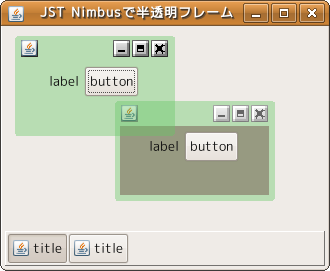Swing/TranslucentFrame のバックアップ(No.21)
- バックアップ一覧
- 差分 を表示
- 現在との差分 を表示
- 現在との差分 - Visual を表示
- ソース を表示
- Swing/TranslucentFrame へ行く。
- 1 (2008-12-01 (月) 15:04:38)
- 2 (2008-12-01 (月) 19:50:49)
- 3 (2008-12-15 (月) 04:24:54)
- 4 (2009-01-16 (金) 16:29:06)
- 5 (2009-05-07 (木) 10:42:38)
- 6 (2009-10-09 (金) 15:11:55)
- 7 (2010-05-24 (月) 15:27:28)
- 8 (2010-11-10 (水) 20:59:48)
- 9 (2011-02-08 (火) 04:02:46)
- 10 (2013-01-13 (日) 19:18:30)
- 11 (2013-05-24 (金) 03:25:25)
- 12 (2013-08-17 (土) 15:40:30)
- 13 (2013-10-10 (木) 19:41:21)
- 14 (2013-10-16 (水) 14:24:13)
- 15 (2014-10-20 (月) 19:41:17)
- 16 (2014-11-01 (土) 00:46:09)
- 17 (2014-12-02 (火) 01:55:04)
- 18 (2015-12-10 (木) 04:08:26)
- 19 (2016-02-03 (水) 18:23:28)
- 20 (2016-09-29 (木) 17:13:15)
- 21 (2017-11-02 (木) 15:34:40)
- 22 (2017-11-10 (金) 14:05:58)
- 23 (2018-02-24 (土) 19:51:30)
- 24 (2019-05-22 (水) 19:35:38)
- 25 (2019-07-09 (火) 19:24:27)
- 26 (2021-03-18 (木) 01:07:37)
- 27 (2022-08-20 (土) 22:15:25)
- 28 (2022-10-01 (土) 05:00:49)
- 29 (2025-01-03 (金) 08:57:02)
- 30 (2025-01-03 (金) 09:01:23)
- 31 (2025-01-03 (金) 09:02:38)
- 32 (2025-01-03 (金) 09:03:21)
- 33 (2025-01-03 (金) 09:04:02)
- 34 (2025-06-19 (木) 12:41:37)
- 35 (2025-06-19 (木) 12:43:47)
- category: swing
folder: TranslucentFrame
title: SynthでJInternalFrameを半透明にする
tags: [JInternalFrame, Translucent, LookAndFeel, UIDefaults, Painter]
author: aterai
pubdate: 2008-12-01T15:04:38+09:00
description: Synthを使ったLookAndFeelで、JInternalFrameを半透明にします。
image:
 hreflang:
hreflang:
href: http://java-swing-tips.blogspot.com/2011/02/translucent-jinternalframe-nimbus.html lang: en
概要
Synthを使ったLookAndFeelで、JInternalFrameを半透明にします。
Screenshot

Advertisement
サンプルコード
try {
for (UIManager.LookAndFeelInfo laf: UIManager.getInstalledLookAndFeels())
if ("Nimbus".equals(laf.getName())) {
UIManager.setLookAndFeel(laf.getClassName());
SynthLookAndFeel.setStyleFactory(
new MySynthStyleFactory(SynthLookAndFeel.getStyleFactory()));
break;
}
}
} catch (Exception e) {
e.printStackTrace();
}
class MySynthStyleFactory extends SynthStyleFactory {
private SynthStyleFactory wrappedFactory;
public MySynthStyleFactory(SynthStyleFactory factory) {
this.wrappedFactory = factory;
}
@Override public SynthStyle getStyle(JComponent c, Region id) {
SynthStyle s = wrappedFactory.getStyle(c, id);
//if (id == Region.INTERNAL_FRAME_TITLE_PANE||id == Region.INTERNAL_FRAME) {
if (id == Region.INTERNAL_FRAME) {
s = new TranslucentSynthStyle(s);
}
return s;
}
}
class TranslucentSynthStyle extends SynthStyle {
private final SynthStyle style;
public TranslucentSynthStyle(SynthStyle s) {
style = s;
}
@Override public SynthPainter getPainter(final SynthContext context) {
return new SynthPainter() {
@Override public void paintInternalFrameBackground(SynthContext context,
Graphics g, int x, int y, int w, int h) {
g.setColor(new Color(100, 200, 100, 100));
g.fillRoundRect(x, y, w - 1, h - 1, 15, 15);
}
};
}
@Override public boolean isOpaque(SynthContext context) {
if (context.getRegion() == Region.INTERNAL_FRAME) {
return false;
} else {
return style.isOpaque(context);
}
}
@Override public Color getColorForState(SynthContext context, ColorType type) {
return null; //Color.RED;
}
@Override public Font getFontForState(SynthContext context) {
return null; //new Font(Font.MONOSPACED, Font.ITALIC, 24);
}
//...
解説
上記のサンプルでは、SynthStyle#paintInternalFrameBackground、SynthStyle#isOpaqueなどのメソッドをオーバーライドしてJInternalFrameを半透明にします。
Synthを使ったLookAndFeelJDK 1.6.0_10で追加されたNimbusLookAndFeelや、GTKLookAndFeelなど
JDK 1.7.0以上でNimbusLookAndFeelを使用する場合、以下のようにUIDefaults#put(...)でjavax.swing.Painterを設定する方法もあります。
- 参考:
- Caffeine Induced Ramblings - Jasper Potts’s Blog » Blog Archive » Nimbus: The New Face of Swing - JavaOne 2008
com.sun.java.swing.plaf.nimbus.NimbusDefaults.java
import java.awt.*;
import javax.swing.*;
import javax.swing.plaf.synth.*;
//import com.sun.java.swing.Painter; // 1.6
import javax.swing.Painter;
public class BackgroundPainterTest {
private final JDesktopPane desktop = new JDesktopPane();
public JComponent makeUI() {
JPanel p1 = new JPanel();
p1.setOpaque(false);
JPanel p2 = new JPanel() {
@Override protected void paintComponent(Graphics g) {
g.setColor(new Color(100, 50, 50, 100));
g.fillRect(0, 0, getWidth(), getHeight());
}
};
p2.setOpaque(false);
UIDefaults d = new UIDefaults();
d.put("InternalFrame[Enabled].backgroundPainter", new Painter<JComponent>() {
@Override public void paint(Graphics2D g, JComponent c, int w, int h) {
g.setColor(new Color(100, 200, 100, 100));
g.fillRoundRect(0, 0, w - 1, h - 1, 15, 15);
}
});
d.put("InternalFrame[Enabled+WindowFocused].backgroundPainter", new Painter<JComponent>() {
@Override public void paint(Graphics2D g, JComponent c, int w, int h) {
g.setColor(new Color(100, 250, 120, 100));
g.fillRoundRect(0, 0, w - 1, h - 1, 15, 15);
}
});
createFrame(p1, d, 0);
createFrame(p2, d, 1);
JPanel p = new JPanel(new BorderLayout());
p.add(desktop);
p.setPreferredSize(new Dimension(320, 240));
return p;
}
protected JInternalFrame createFrame(JPanel panel, UIDefaults d, int idx) {
MyInternalFrame frame = new MyInternalFrame();
frame.putClientProperty("Nimbus.Overrides", d);
//frame.putClientProperty("Nimbus.Overrides.InheritDefaults", false);
frame.setOpaque(false);
if (panel != null) {
frame.setContentPane(panel);
panel.add(new JLabel("label"));
panel.add(new JButton("button"));
frame.getRootPane().setOpaque(false);
}
desktop.add(frame);
frame.setVisible(true);
frame.setLocation(10 + 60 * idx, 10 + 40 * idx);
desktop.getDesktopManager().activateFrame(frame);
return frame;
}
static class MyInternalFrame extends JInternalFrame {
public MyInternalFrame() {
super("title", true, true, true, true);
setSize(160, 100);
}
}
public static void main(String[] args) {
EventQueue.invokeLater(new Runnable() {
@Override public void run() {
createAndShowGUI();
}
});
}
public static void createAndShowGUI() {
try {
for (UIManager.LookAndFeelInfo laf : UIManager.getInstalledLookAndFeels()) {
if ("Nimbus".equals(laf.getName())) {
UIManager.setLookAndFeel(laf.getClassName());
break;
}
}
} catch (Exception e) {
e.printStackTrace();
}
JFrame frame = new JFrame();
frame.setDefaultCloseOperation(WindowConstants.EXIT_ON_CLOSE);
frame.getContentPane().add(new BackgroundPainterTest().makeUI());
frame.pack();
frame.setLocationRelativeTo(null);
frame.setVisible(true);
}
}
